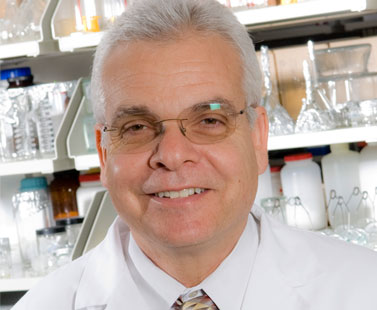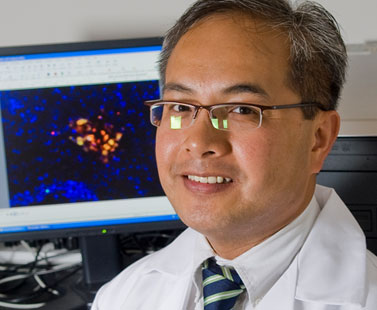USF stem cell scientists call for research ethics consortium
Emerging biotechnologies need “honest broker” independent of government, religious, political and scientific organizations
Tampa, FL (Sept. 20, 2010) – Two University of South Florida stem cell researchers propose creating an independent national “Stem Cell Research Ethics Consortium” to provide better guidance on stem cell issues for regulatory agencies, law makers and policy makers. Their recommendation is timely, and came before the recent ruling by a U.S. judge that halted expansion of federal funding for embryonic stem cell research. The ruling reversed the attempt to overturn the standing moratorium on federal funding for such research and subsequent appeals.
USF neuroscientists Dr. Paul Sanberg and Dr. Cesario Borlongan are pioneers in the development of umbilical cord blood and adult stem cells for use as therapies for stroke, neurodegenerative diseases and cardiovascular disease. Their commentary appears in the journal, TECHNOLOGY and INNOVATION – The Proceedings of the National Academy of Inventors (Vol. 12 No. 1). Co-authors of the paper were Camille McWhirter, JD, and Caroline Fultz-Carver, PhD, of the USF Office of Research & Innovation and Kevin T. FitzGerald of Georgetown University Medical Center.
“Two decades of cell-based research has been accompanied by poor management of public discussion regarding ethics,” said Dr. Sanberg, executive director of the USF Center of Excellence for Aging and Brain Repair. “Stem cell science has contributed to misperceptions within the public and the research communities, and those misperceptions have hindered the progress of scientific innovation. As a result, clinical application of potentially life-saving treatments to critically ill patients has been delayed and, in some cases, impeded.”
According to co-author Dr. Borlongan, vice chairman for research in the USF Department of Neurosurgery and Brain Repair, discussion of the emerging technologies for stem cell-based therapies has often been driven by conflict rather than fact.
“Because of the lack of effective communication between scientists and the public, conflicts have largely played out in the media,” Dr. Borlongan said. “In some respects, the failure of the scientific community to effectively address controversy in stem cell research has helped create today’s heated, yet poorly informed, debate. We need a Stem Cell Ethics Research Consortium, independent of governmental, political, religious, and scientific organizations, comprised of diverse interests, to sort out the ethical, legal and social issues, and then determine an appropriate mechanism for public discourse and policy making.”


Dr. Paul Sanberg, left, and Dr. Cesario Borlongan, research and develop umbilical cord blood and adult stem cells as potential treatments for stroke, neurodegenerative diseases and cardiovascular disease.
The proposed Consortium, conceived as an independent, “honest broker,” would be useful in shaping policy on all emerging technologies, not just stem cell science, said Drs. Sanberg and Borlongan. They advocate using members of diverse focus groups to identify issues and discuss them with various communities and return with recommendations. Accordingly, the Consortium’s first task would be to establish baseline data about the public view on stem cell science. Collected data should be analyzed to assess the range of options, beliefs and concerns of focus group members’ constituents.
The USF researchers envision the Consortium playing a proactive rather than a reactive role and contribute to a deliberate assessment of public opinion about stem cell research aimed at revising or creating meaningful oversight.
“An informed Consortium can then provide ethically-based regulatory options to NIH for use in its ongoing development of guidelines for all stem cell research, not just for embryonic stem cells,” said Dr. Sanberg. “The members of the Consortium, enlisted from a wide variety of stakeholders, could evaluate how novel ethical issues in emerging technologies are addressed under current oversight and regulatory structures and where there may be gaps and need for revision or new policy approaches.”
The Consortium, suggests Dr. Sanberg, could also be charged with determining the best uses of public funds in investigations of not only stem cells, but other emerging technologies, such as energy, nanotechnology and personalized medicine.
“Bringing together all stakeholders – including the legal, scientific, religious and the public sectors – should allow a much more educated and logical approach in handling the public disbursement of funds for stem cell research,” concluded Drs. Sanberg and Borlongan.
About the Center of Excellence for Aging and Brain Repair
The mission of the Center of Excellence for Aging and Brain Repair is to develop new therapeutic strategies to promote repair and regeneration of aging and diseased brain. Building on a foundation of excellence in basic and clinical research, we focus on translating innovative ideas into industrial partnerships, educational and clinical services to address key needs of the community and those suffering from brain injury and disease.
Release by Randolph Fillmore, USF Center of Excellence for Aging and Brain Repair
Photos by Eric Younghans, USF Health Communications

